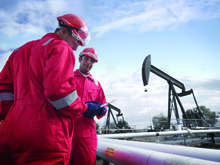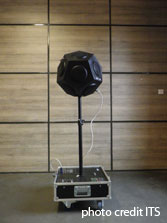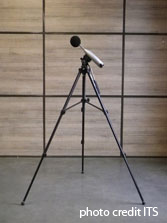History of company ITS
The human resource of ITS had over the last twenty years professional activities having led to participate in the development of structures in relation to acoustics / noise control engineering for which this human resource has (consequently) various know-how concerning physical principles and applications:
- design / selection / development of soundproofing products and systems, research and development (1)
- acoustic metrology (in-situ and in laboratory), studies, prescriptions, design, pricing, project management, engineering for constructions and turnkey erections (acoustic insulation), technical sales services in relation with soundproofing materials and equipments (1)
- noise control engineering: calculations, design, sizing (2)(3)(4)
1 in terms of acoustics essentially 2 acoustic multilayered structures: partitions or absorbent linings and dissipative silencers: low or high temperature ... 3 enclosures, screens, laggings, suspended acoustical ceilings, wall cladding for reverberation treatment of rooms... 4 calculations of sound propagation indoor or outdoor, and from inside to outside of a building ...
Whereas some aspects of those different professional occupations held in the past by the human resource of ITS (always: in relation to acoustic insulation) are not currently fully included in the scope of the present activity of ITS because of its current mission and organization, they provide a background founding the multi-competence approach proposed by ITS for all projects of fight against noise or of improvement of the acoustic comfort.
 |
The on-site (e.g. in industry) intervention of ITS human resource is often used to collect information useful for the analysis of a situation in terms of acoustics (e.g. in the context of fight against noise at work or of prevention of noise pollution in the vicinity of a facility). The constructive dialogue with the various stakeholders of a soundproofing project is always needed to allow the best solutions to be developed by ITS. |
The human resource of ITS has a good overall knowledge of the field of passive acoustic insulation (at workplaces, in industry, in environment, in the energy sector, for testing rooms, in building) through the experience gained during the various positions held (sometimes using English and German) in companies with integrated engineering department, having led to be familiar with worlds as diverse as laboratory and field.
The human resource of ITS also has a fairly good knowledge of related areas of activity (aerodynamics, thermal insulation, construction) as well as various industrial processes and equipments.
This experience enables ITS to be able to successfully confront issues related to acoustic insulation of a high degree of technicality and manage related issues: technical and of all other type.
The human resource of ITS had professional activities in relation to acoustics / noise control engineering.
Means of acoustic measurement
ITS has own means of acoustic measurements to apprehend the most common and other more complex acoustic situations (on-site). Those means are suitable for noise measurement at a workstation or near a machine, to measure noise emissions in the environment, or for the metrology related to acoustic comfort of premises and buildings (depending on the context: for single frequencies, in 1/3 octave bands or in octave bands, for frequencies from 125 Hz to 4 kHz or in a wider frequential interval).
|
ITS omnidirectionnal |
ITS |
|
ITS omnidirectional noise source, consisting of a dodecahedron, containing a power amplifier and a noise generator (e.g. pink, white) has a sound power level greater than 120 dBLin (e.g. for sound reduction and reverberation time measurements) ; it is used for many acoustic measurements:
- sound level difference (expressed in decibels) i.e. the difference between the sound pressure level in two spaces (e.g. two adjacent rooms, or a room and the exterior of a building or a construction in an enclosed space)
- reverberation time (expressed in seconds) i.e. the time required for the existing sound level in a room to decrease by 60 dB when the noise source is instantly interrupted
- the spatial decay rate slope in decibels of the spatial sound decay curve over a given distance range, when the distance to the noise source doubles
ITS is equipped for the measurements of the sound pressure level per frequency band (real time spectral analysis), allowing the analysis of temporal evolution of acoustic situations, the measurement of the reverberation time of rooms as well as spatial sound decay in rooms and of airborne sound insulation performance between premises or with respect to outside.
ITS sonometer (class 1) namely measures equivalent continuous sound levels Leq, pressure levels Lp (time weightings S, F, I), with the usual frequency weightings (e.g. A) and peak levels Lpk envisaged by the various sound measurements standards applicable depending on the context (e.g. regulatory). Also recording the 1/1 octave and 1/3 octave spectral distributions, it is used for many acoustic measurements:
- associated with the omnidirectional noise source, for all the metrologies listed above
- alone, when it comes to measuring a sound pressure level, e.g. to quantify the sound emissions of a machine or a facility, the noise exposure of an employee, the noise annoyance suffered by a neighbor
- sonometer class 1 (for the measurement of sound pressure levels: quantity 4 among which 1 allows the measurement of the reverberation time)
- acoustic pressure calibrator class 2
- noise generator
- associated data processing software
ITS has acoustic measurement means (industry, building): sound level meter, calibrator, noise generator, data processing software.
Verification and calibration are carried out in accordance with the ISO 9001 standard (Quality management systems - Requirements), for which ITS has a periodically renewed certification.
Means of simulation and of computation for acoustic prediction
The old experience in the field of soundproofing in all sectors of activity has enabled the development of predicting acoustic calculation software capitalizing on the expertise of human resources of ITS.
ITS is thus equipped with means of simulations suitable for the most common and other more complex acoustic computation and prediction issues.
- useful for various phases of projects including: diagnosis of a situation in terms of acoustic, search for solutions in relation to a situation in terms of acoustics
- founding the crucial phase of projects that is the performance of soundproofing equipment sizing sheets
- allowing the selection of products and construction systems optimized with respect to the data and constraints taken into account and to the objective of result in terms of acoustics
The means of simulation of ITS are the basis of technological choices the most appropriate to the considered situation and base the acoustic guarantee that is attached to the supply of soundproofing equipment, their installation or the execution of acoustic insulation .
Most of the software allowing acoustic predicting computation at ITS have been developed internally, which allows the integration of experience data complementing the best theoretical approaches of all times carefully selected in order to base the simulation models.(1) (2) (3) (4)
1 in terms of acoustics essentially 2 acoustic multilayered structures: partitions or absorbent linings and dissipative silencers: low or high temperature ... 3 enclosures, screens, laggings, suspended acoustical ceilings, wall cladding for reverberation treatment of rooms... 4 calculations of sound propagation indoor or outdoor, and between inside and outside of a building ...
acoustic measurements analysis
- calculations in relation to the determination of sound insulation performances of enclosures: according to measurements on site
- calculations in relation to the determination of sound power levels of facilities for the evaluation of sound pressure levels in the environment
- calculations in relation to the determination of sound power levels emitted by noise sources from the sound pressure
- calculations in relation to the determination of spatial sound decay in industrial premises, tertiary premises and in subsets of buildings
- calculations in relation to the determination of reverberation time in industrial premises, tertiary premises and in subsets of buildings
- calculations in relation to the measurement of sound absorption in a reverberation room
- calculations in relation to the measurement of sound insulation in buildings and of building elements
- calculations in relation to the measurement of the performance of ducted silencers: insertion loss, flow noise and total pressure loss
computations
- calculation of the attenuation of sound during propagation outdoors (including: calculation of atmospheric attenuation)
- calculation of the acoustic performance in buildings from the performance of elements: acoustic absorption of rooms and enclosed spaces
- calculation of the acoustic performance in buildings from the performance of elements: sound insulation between premises
- calculation of the acoustic performance in buildings from the performance of elements: insulation from noise coming from outside
- calculation of the acoustic performance in buildings from the performance of elements: transmission of indoor sound to the outside
- determination of the levels of emission sound pressure at the workplace and at other specified positions from the sound power level
- calculations in relation to the determination of sound power levels of facilities for the evaluation of sound pressure levels in the environment
- calculations in relation to the determination of sound power levels emitted by noise sources from the sound pressure
- calculation of sound propagation and noise prediction in workrooms
- calculation of the spatial sound decay of industrial premises, tertiary premises or of subsets of buildings
- calculation of the reverberation time of industrial premises, tertiary premises or of subsets of buildings
- prediction of sound impact of aeraulic systems
sizing
- calculation of the performance of an acoustic screen
- prediction of the performance of dissipative silencers: insertion loss, flow noise and total pressure loss
- prediction of the performance of resonnant: insertion loss, flow noise and total pressure loss
- prediction of the sound reduction index of ducts (ducts and pipes)
- prediction of the sound reduction index of multilayered partitions: plane or orthotropic
- prediction of the sound absorption coefficient for normal incidence of multilayered partitions: plane or orthotropic
- prediction of the Sabine's factor of multilayered partitions: plane or orthotropic
ITS has means for simulation & for computation (claculation, modelling) in acoustics (industry, building) for the generation, propagation and reduction of noise. Commercial software (based on sound ray tracing for the study of sound propagation in rooms, based on finite element calculations for the study of sound propagation in ducts and silencers) and software developed in-house SILDIS®: cf . link below) are available for the experienced human resource of ITS.



